Pipeline terminal set for Fort

Article content
As Fort Saskatchewan continues to be a hub for industrial development, the city is getting set to play host to what’s been referred to as an important stepping stone for bitumen production.
The Heartland Pipeline and TC Terminal was announced in May by TransCanada in an effort to support a growing crude oil production industry in Alberta.
Mapped out to include 200 kilometres of pipe connecting the Capital Region with facilities in Hardisty, Alta., the Heartland Pipeline Project will plant its end game in Fort Saskatchewan.
“With Alberta oil production projected to increase by almost three-million barrels per day over the next 15 years, it is important to have the right infrastructure in place to move these resources safely and reliably to market at the right time,” said Alex Pourbaix, TransCanada’s president of energy and oil pipelines.
“These projects will help link Canadian crude oil resources in northern Alberta to markets in eastern Canada and the United States.”
Estimates given by TransCanada outline up to 900,000 barrels of crude oil being transported by day, while the Fort Saskatchewan terminal is expected to have storage capacity of up to 1.9 million barrels.
“We are seeing that the (Industrial) Heartland is very quickly becoming the hub of activity for the movement of bitumen,” said Neil Shelly, executive director of Alberta’s Industrial Heartland Association.
He continued: “If we look (at some of) the other projects that are going on, we see (them) as supplementing the existing assets that we have here, making us the choice destination for bitumen coming into the region.”
The total projected cost of the Heartland Pipeline is reaching $900 million, with the local terminal — along with the pipeline — expected to come into service by 2015.
“TransCanada, in combinations with the (other industry groups), is making the Heartland the bitumen hub of Alberta,” Shelly said.
“And by being the bitumen hub of Alberta, companies that are looking to upgrade or process it... basically want to be where the hub is so you can get access to multiple feedstocks.”
Initial engagement between TransCanada and stakeholders or Aboriginal communities kicked off in the fall of 2012.
—With files from Sun Media
ben.proulx@sunmedia.ca
twitter.com/Ben_Proulx